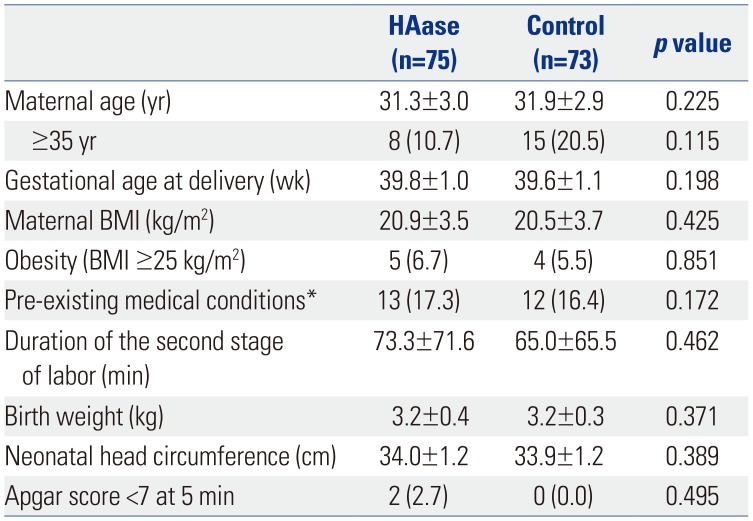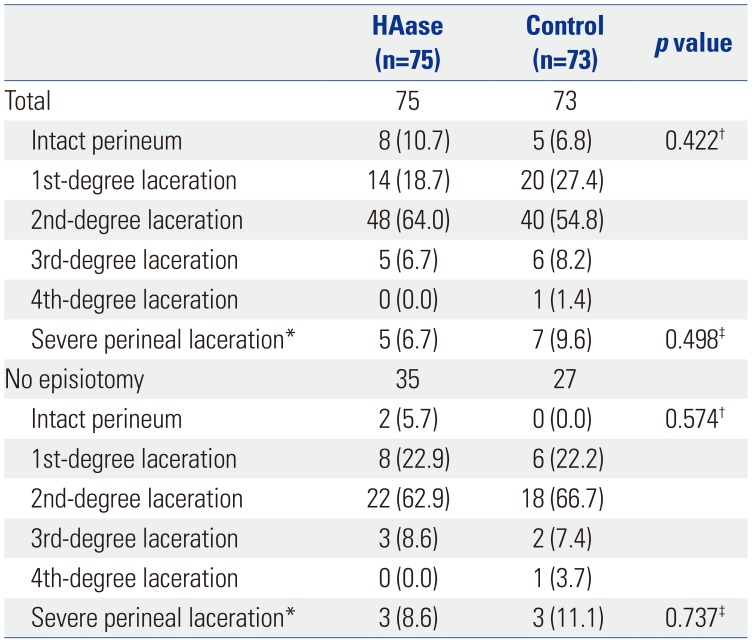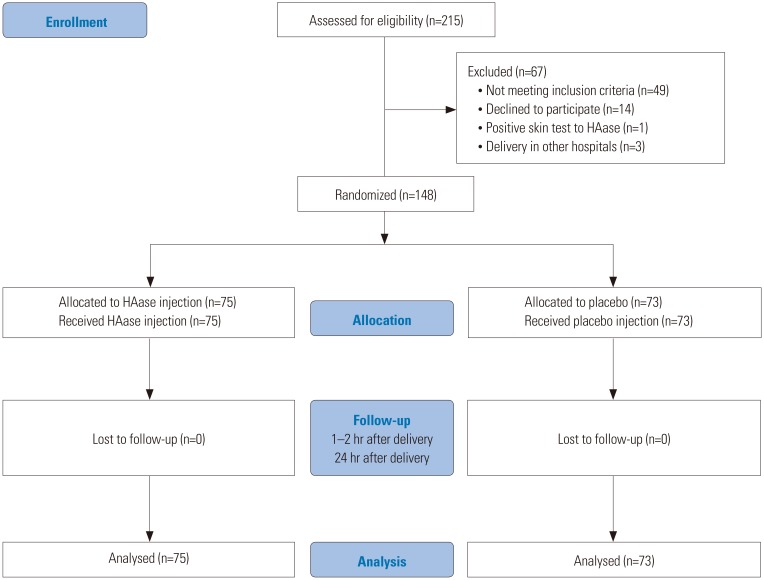1. Baumann P, Hammoud AO, McNeeley SG, DeRose E, Kudish B, Hendrix S. Factors associated with anal sphincter laceration in 40,923 primiparous women. Int Urogynecol J Pelvic Floor Dysfunct. 2007; 18:985–990. PMID:
17211527.

2. Fernando RJ, Sultan AH, Kettle C, Thakar R. Methods of repair for obstetric anal sphincter injury. Cochrane Database Syst Rev. 2013; (12):CD002866. PMID:
24318732.

3. Frohlich J, Kettle C. Perineal care. BMJ Clin Evid. 2015; 2015:1401.
4. Marschalek ML, Worda C, Kuessel L, Koelbl H, Oberaigner W, Leitner H, et al. Risk and protective factors for obstetric anal sphincter injuries: a retrospective nationwide study. Birth. 2018; 45:409–415. PMID:
29537100.

5. Pauls RN, Silva WA, Rooney CM, Siddighi S, Kleeman SD, Dryfhout V, et al. Sexual function following anal sphincteroplasty for fecal incontinence. Am J Obstet Gynecol. 2007; 197:618. PMID:
18060952.

6. Bagade P, Mackenzie S. Outcomes from medium term follow-up of patients with third and fourth degree perineal tears. J Obstet Gynaecol. 2010; 30:609–612. PMID:
20701512.

7. Priddis H, Schmied V, Dahlen H. Women's experiences following severe perineal trauma: a qualitative study. BMC Womens Health. 2014; 14:32. PMID:
24559056.

8. Menzel EJ, Farr C. Hyaluronidase and its substrate hyaluronan: biochemistry, biological activities and therapeutic uses. Cancer Lett. 1998; 131:3–11. PMID:
9839614.

9. Lv SH, Rong SF, Cai BG, Guan SM, Li QQ. Property and current clinical applications of mammal hyaluronidase. Eur Rev Med Pharmacol Sci. 2015; 19:3968–3976. PMID:
26531287.
10. Brown CR. Distribution of hyaluronidase in the ram spermatozoon. J Reprod Fertil. 1975; 45:537–539. PMID:
1243148.

11. Yuda Y, Kasashima Y, Kuwano A, Sato K, Hattori S, Arai K. Active hyaluronidase 2 expression in the granulation tissue formed in the healing process of equine superficial digital flexor tendonitis. J Vet Med Sci. 2013; 75:219–223. PMID:
23047331.

12. Narayanan R, Kuppermann BD. Hyaluronidase for pharmacologic vitreolysis. Dev Ophthalmol. 2009; 44:20–25. PMID:
19494648.

13. Wohlrab J, Finke R, Franke WG, Wohlrab A. Clinical trial for safety evaluation of hyaluronidase as diffusion enhancing adjuvant for infiltration analgesia of skin with lidocaine. Dermatol Surg. 2012; 38:91–96. PMID:
22093158.

14. Scarabotto LB, Riesco ML. Use of hyaluronidase to prevent perineal trauma during spontaneous delivery: a pilot study. J Midwifery Womens Health. 2008; 53:353–361. PMID:
18586189.

15. Zhou F, Wang XD, Li J, Huang GQ, Gao BX. Hyaluronidase for reducing perineal trauma. Cochrane Database Syst Rev. 2014; (2):CD010441. PMID:
24497276.

16. Digonnet L, Cahn J, Roy J, Boucet J. [Effect of local injection of hyaluronidase on perineal distention in labor in primiparas]. Therapie. 1952; 7:388–391. PMID:
13049228.
17. Frenzel KH. Protection of the perineum with hyaluronidase. Zentralbl Gynakol. 1954; 76:1602–1604. PMID:
14349182.
18. Mink E. [Experience with the softening effect of hyalurodase on high and rigid perineum in primiparas]. Geburtshilfe Frauenheilkd. 1955; 15:246–258. PMID:
14380684.
19. Rimbach E, Griefahn S. Critical evaluation of perineum protection with hyaluronidase. Zentralbl Gynakol. 1955; 77:546–548. PMID:
14397711.
20. Patrini G. [Usefulness of hyaluronidase in labor as protector of the perineum]. Riv Ostet Ginecol Prat. 1956; 38:710–714. PMID:
13380314.
21. Petronio G. [Protective action of hyaluronidase on vaginoperineal lesions from spontaneous and surgical labor]. Minerva Med. 1956; 47:2071–2073. PMID:
13399919.
22. Chatfield WR, Moir DD. The effect of hyaluronidase on the perineum. A controlled trial of 200 primigravid patients in labour. J Obstet Gynaecol Br Commonw. 1966; 73:670–671. PMID:
5912630.

23. Colacioppo PM, Gonzalez Riesco ML, Koiffman MD. Use of hyaluronidase to prevent perineal trauma during spontaneous births: a randomized, placebo-controlled, double-blind, clinical trial. J Midwifery Womens Health. 2011; 56:436–445. PMID:
23181640.

24. Hulley SB, Cummings SR, Browner WS, Grady DG, Newman TB. Designing clinical research. 3rd ed. Philadelphia (PA): Lippincott Williams & Wilkins;2007.
25. Sultan AH, Fernando R. Maternal obstetric injury. Curr Obstet Gynaecol. 2001; 11:279–284.

26. Hogan MA, Madayag T. Medical-surgical nursing: reviews and rationales. 2nd ed. Salt Lake City (UT): Prentice Hall;2007.
27. Kwon HY, Park HS. Episiotomy and the risk of severe perineal injuries among Korean women. J Matern Fetal Neonatal Med. 2017; 30:1745–1749. PMID:
27549862.

28. O'Leary JA, Erez S. Hyaluronidase as an adjuvant to episiotomy. Obstet Gynecol. 1965; 26:66–69.
29. Senol DK, Aslan E. The effects of cold application to the perineum on pain relief after vaginal birth. Asian Nurs Res. 2017; 11:276–282.








 PDF
PDF ePub
ePub Citation
Citation Print
Print





 XML Download
XML Download